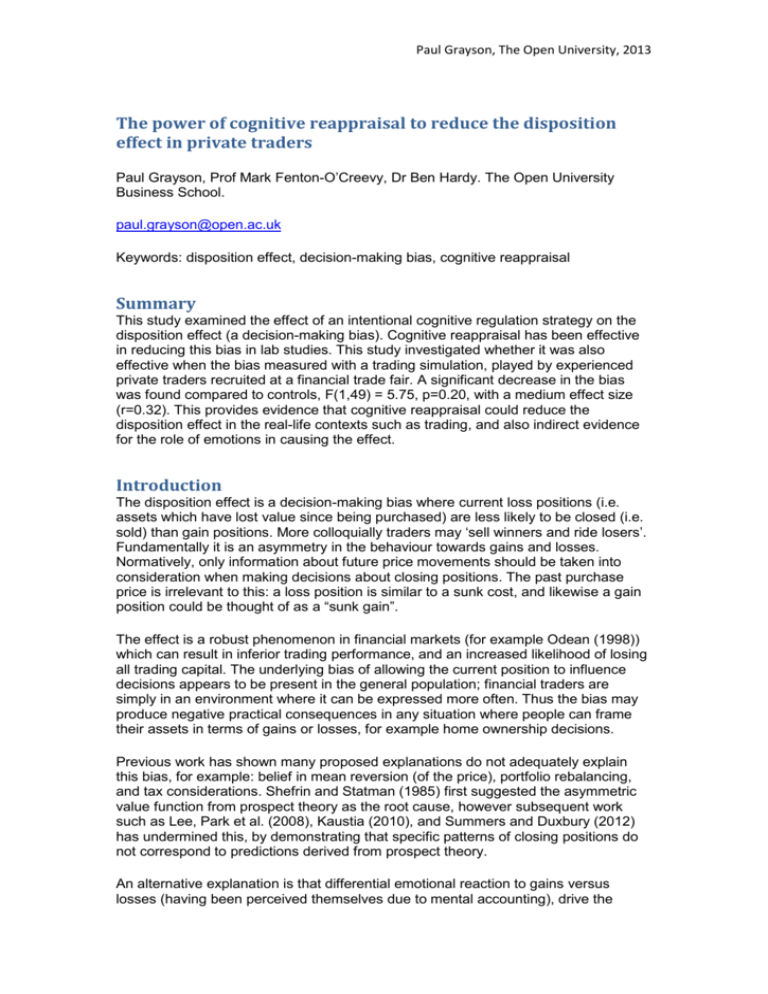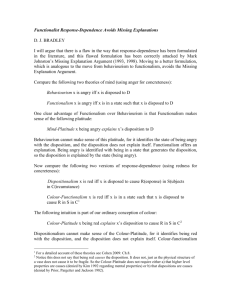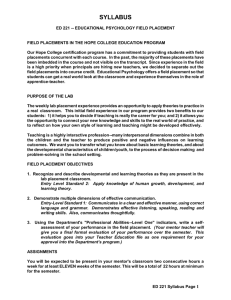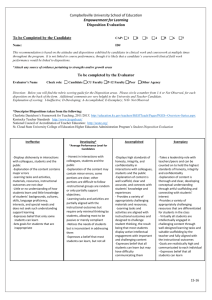The power of cognitive reappraisal to reduce the disposition effect in
advertisement

Paul Grayson, The Open University, 2013 The power of cognitive reappraisal to reduce the disposition effect in private traders Paul Grayson, Prof Mark Fenton-O’Creevy, Dr Ben Hardy. The Open University Business School. paul.grayson@open.ac.uk Keywords: disposition effect, decision-making bias, cognitive reappraisal Summary This study examined the effect of an intentional cognitive regulation strategy on the disposition effect (a decision-making bias). Cognitive reappraisal has been effective in reducing this bias in lab studies. This study investigated whether it was also effective when the bias measured with a trading simulation, played by experienced private traders recruited at a financial trade fair. A significant decrease in the bias was found compared to controls, F(1,49) = 5.75, p=0.20, with a medium effect size (r=0.32). This provides evidence that cognitive reappraisal could reduce the disposition effect in the real-life contexts such as trading, and also indirect evidence for the role of emotions in causing the effect. Introduction The disposition effect is a decision-making bias where current loss positions (i.e. assets which have lost value since being purchased) are less likely to be closed (i.e. sold) than gain positions. More colloquially traders may ‘sell winners and ride losers’. Fundamentally it is an asymmetry in the behaviour towards gains and losses. Normatively, only information about future price movements should be taken into consideration when making decisions about closing positions. The past purchase price is irrelevant to this: a loss position is similar to a sunk cost, and likewise a gain position could be thought of as a “sunk gain”. The effect is a robust phenomenon in financial markets (for example Odean (1998)) which can result in inferior trading performance, and an increased likelihood of losing all trading capital. The underlying bias of allowing the current position to influence decisions appears to be present in the general population; financial traders are simply in an environment where it can be expressed more often. Thus the bias may produce negative practical consequences in any situation where people can frame their assets in terms of gains or losses, for example home ownership decisions. Previous work has shown many proposed explanations do not adequately explain this bias, for example: belief in mean reversion (of the price), portfolio rebalancing, and tax considerations. Shefrin and Statman (1985) first suggested the asymmetric value function from prospect theory as the root cause, however subsequent work such as Lee, Park et al. (2008), Kaustia (2010), and Summers and Duxbury (2012) has undermined this, by demonstrating that specific patterns of closing positions do not correspond to predictions derived from prospect theory. An alternative explanation is that differential emotional reaction to gains versus losses (having been perceived themselves due to mental accounting), drive the Paul Grayson, The Open University, 2013 asymmetry in behaviour. It follows from this that improved emotion regulation may reduce the bias, and emotion regulation in the form of cognitive reappraisal has been effective at reducing the bias in lab studies (Lee et al 2008). Research question and methods This study asked whether cognitive reappraisal could be effective at reducing the disposition effect in a more realistic task using expert participants. Field studies of the disposition effect calculate individuals’ biases using their trading record from real-life trading. This study attempted to test cognitive reappraisal as a de-biasing intervention, under conditions closer to those of field studies. In place of students or other lay individuals, we recruited private traders at a trading conference run by the Italian Stock Exchange (Borsa Italiana) in Milan. These individuals trade using their own capital and have knowledge of common trading techniques and strategies. It is difficult to carry out a controlled study of how a prescribed emotion regulation technique affects real-life trading. So, to derive an estimate of the disposition effect participants played a trading simulation, which had been specifically created for studying the disposition effect on a previous research project. This game presents a continuous index with real-time price information, and allows participants to open and close long and short positions on whatever basis they choose, at any time during the 10 minute simulation. In order to further increase the complexity of the game and its similarity to the context that real trading decisions are made in, it also presents another continuous index with predictive information (of undisclosed reliability) about future price movements. Participants played the simulation four times in total, with each play generating a record of their trading decisions which was used to calculate a disposition effect score. This is based on the number of gain and loss positions closed, relative to the amount of time spent holding gains and losses (analogous to Odean’s measure using PGR and PLR). After the penultimate play of the simulation, the treatment group were asked to implement a cognitive reappraisal instruction during the final play: they were asked them to imagine they were an investment manager trying to maximise returns on behalf of others, while the control group were simply asked to play again and focus on maximising returns. Results Reliability of the simulation in measuring the bias The simulation produces consistent disposition effect scores within participants, with bivariate correlations varying between 0.77 < r < 0.87. This was expected since the simulation had received some testing beforehand and was designed specifically to provide a reliable disposition effect score in a short amount of time. Figures 1 and 2 below are scatterplots comparing the disposition effect scores from the 2nd versus the 3rd play, and the 3rd play versus the 4th play, for each participant. A score of 0 corresponds to no bias. (Note that scores on the 4th play include participants from both treatment and control groups, so this group difference acts as noise when estimating the correlation coefficient.) Paul Grayson, The Open University, 2013 Figures 1 and 2: Scatterplots of the disposition effect score for the 2nd versus 3rd, and 3rd versus 4th plays, for each participant Changes in disposition effect score over successive plays The average disposition effect score increased with each play of the simulation (excluding the final play for the treatment group). This was expected since, as participants became more familiar with the simulation, they could focus less attention on its operational aspects and more on information provided to them such as current position. This should increase their presentation of biases based on that information, such as the disposition effect. In addition, successive plays may result in ego depletion, exacerbating the effect of task-irrelevant emotional reactions during the game. Figure 3 below shows the progression of disposition effect scores for the 2nd, 3rd and 4th plays. The reappraisal group is shown in blue and the control group in green. The decrease on the reappraisal group’s last play is discussed below. Figure 3 – disposition effect scores over successive plays, for each group Test of the effect of cognitive reappraisal compared to controls The main test of the study was a comparison of each participant’s disposition effect scores on the 3rd and 4th plays, for the control and cognitive reappraisal groups. A Paul Grayson, The Open University, 2013 2x2 mixed ANOVA found a significant interaction between play order and group, in the direction predicted. Cognitive reappraisal produced a significant decrease in the disposition effect compared to controls, F(1,49) = 5.75, p=0.20, with a medium effect size (r = 0.32). Figure 4 below shows the absolute change in the disposition effect score for each group, from the 3rd play to the 4th. Figure 4 – absolute change in disposition effect scores between 3rd and 4th plays, for each group Discussion This result provides evidence that cognitive reappraisal may be effective in reducing the disposition effect (and perhaps emotionally-driven decision-making biases in general) in real world contexts such as during trading. It also provides indirect evidence that emotional reactions towards gain and loss positions are the cause of the disposition effect. An unexpected finding was that the reappraisal group had a higher overall disposition effect score compared to the control group. This was surprising since the two groups were randomly assigned, and there was no difference in procedure between them until receiving the cognitive reappraisal instruction immediately prior to playing the simulation the final (4th) time. It cannot be ruled out that the reappraisal group displayed a higher average disposition effect score by chance, despite random assignment, and that the significant interaction found is caused by mean reversion. However this worry is somewhat mitigated by the higher disposition effect scores found on both the 2nd and 3rd plays of the simulation for the reappraisal group, which only disappeared on the 4th play when cognitive reappraisal was introduced. In addition the high reliability of the disposition effect scores within participants across plays seems unlikely occur if large group differences are also occurring by chance. An extension of this research would be testing the intervention with participants trading their own money on real markets. However such experiments obviously pose significant practical problems in terms of gaining consent to participate, and liability of the researchers for any economic losses sustained. The exact mechanism by which Paul Grayson, The Open University, 2013 cognitive reappraisal reduces the bias, such as testing directly whether a reduction in emotional reactions underlies it, is also an avenue for future enquiry. Another study currently in progress has a similar design to this one. However the emotion regulation used for the treatment group is a 4 week mindfulness training course, rather than a short cognitive reappraisal instruction. A separate set of participants were recruited for this study from a financial trade fair held in London. The results of this study may be available by the time of the BFWG meeting to discuss as well. References Kaustia, M. (2010). "Prospect theory and the disposition effect." Journal of Financial and Quantitative Analysis 45(03): 791-812. Lee, H. J., J. Park, et al. (2008). "Disposition effects and underlying mechanisms in e-trading of stocks." Journal of Marketing Research 45(3): 362-378. Odean, T. (1998). "Are investors reluctant to realize their losses?" Journal of Finance: 17751798. Shefrin, H. and M. Statman (1985). "The disposition to sell winners too early and ride losers too long: Theory and evidence." Journal of Finance 40(3): 777-790. Summers, B. and D. Duxbury (2012). "Decision-dependent emotions and behavioral anomalies." Organizational Behavior and Human Decision Processes.






